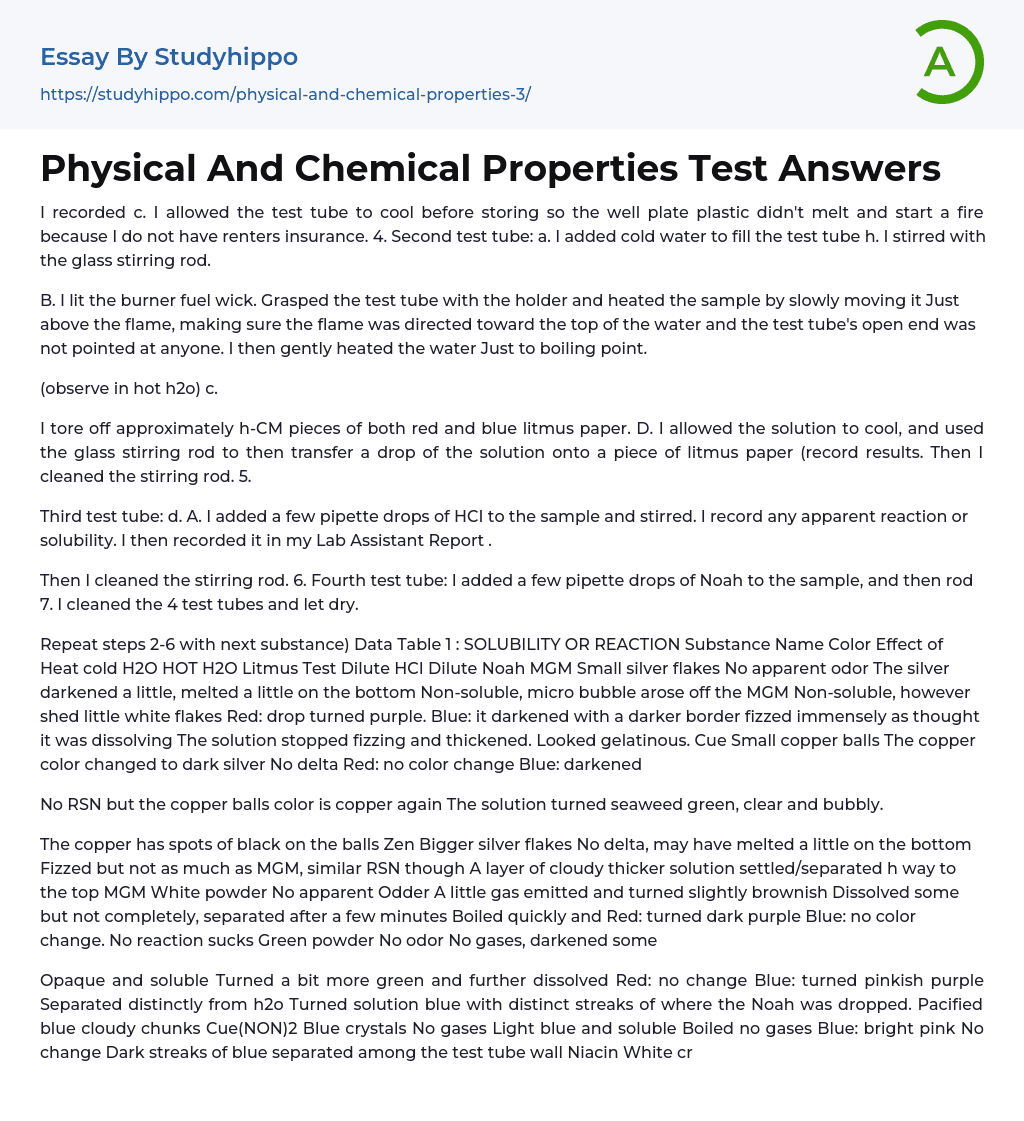

Physical And Chemical Properties Test Answers Essay Example
To ensure safety and prevent any damage, I allowed the first test tube with substance c to cool down before storage. For the second test tube, I filled it with cold water and stirred it using a glass stirring rod. I then carefully heated the sample over a burner fuel wick, ensuring that the flame was directed towards the top of the water and not at anyone. Using red and blue litmus paper torn into approximately h-CM pieces, I recorded results by transferring a drop of solution onto each piece after cooling and cleaning the stirring rod. Upon adding a few pipette drops of HCI to the third test tube, observing any apparent reaction or solubility, I recorded these observations in my Lab Assistant Report before cleaning the rod. Lastly, for the fourth test tube, I added Noah to it using
...a rod and cleaned all four tubes before leaving them to dry.
Repeat steps 2-6 for next substance.
Table 1 displays information on the solubility and reaction of various substances to different conditions such as cold and hot water, heat, litmus test, dilute HCl, and Noah M. The table includes substance names, colors, effects of heat, reactions in cold and hot water, results from the litmus test and dilute HCl tests.
Small silver flakes had no apparent odor but darkened a little with some melting on the bottom when heated. It was non-soluble in both cold and hot water but shed small white flakes with hot water. The litmus test resulted in purple for red drops and darkening with fizzing for blue drops while dilute HCI made the solution thickened to a gelatinous texture.
Smal
copper balls changed color from copper to dark silver without any significant change when exposed to high temperature. In cold water solutions it showed no alteration with red drops while blue ones became darker. There were no visible changes after being placed in boiling-hot water except for spots of black appearing on the balls which turned seaweed green during the litmus test.
Bigger silver flakes did not show much difference during heating except that they may have melted slightly at their base. They produced similar results as MGM when reacting with other elements on all tests except boiled quickly turning into a dark brown color once dissolved partially before separating halfway through settling down over time.
| Red: The drop turned purple. Blue: It darkened with a darker border and fizzed immensely as though it was dissolving. The solution stopped fizzing and thickened, looked gelatinous. | Cue | N/A | ||||
| White powder MGM | No apparent odor. | A little gas emitted and turned slightly brownish. Dissolved some but not completely, separated after a few minutes. Boiled quickly and turned dark brown. | Red: Turned dark purple. Blue: No color change. | N/A | N/A | |
| The green powder showed no reaction, odor or gases, but darkened slightly. It was opaque and soluble. When tested with red, there was no change, but with blue it turned pinkish-purple and separated from the water.Blue cloudy chunks pacified and turned the solution blue, with distinct streaks of where Noah was dropped.Non(NON)2 produced blue crystals that boiled without gases and were light blue and soluble.When blue was added, it turned bright pink.There was no change in the solution,but dark streaks of blue separated among the test tube wall.Niacin created white crystals that were non-soluble at
first,but then dissolved when heated with water.When blue was added,it remained clearand soluble.The chunk of Niacin appeared to dissolve and be soluble immediatelyafter coldand hot H2O,but thenseparated after a few minutes.Therefore,itwas non-soluble. |
Throughout the experiment, I have witnessed a variety of alterations in chemical properties that can indicate the inclination of substances to experience chemical transformations. Such changes result from chemical reactions and generate new entities. For instance, when copper was cooled down, its surface turned dark black due to a reaction with O2 that produced copper (II) oxide. Additionally, another reaction occurred on the metal's surface. Moreover, I have also observed a chemical change while dissolving NCAA with H2O D. The question arises whether this is a physical or chemical change.
Physical Silver metallic color; Melts at 98 degrees C; Water freezes at zero degrees; Ice cubes in a freezer get smaller with time; Baking soda loses mass as it is heated.
Chemical Turns gray in the air; Reacts explosively with chlorine gas; Baking soda when combined with vinegar and bubbles; Tarnishing of silver.
Furthermore, dissolving salt is considered a physical change because even though there is dissociation involved, boiled-off salt remains unchanged chemically.F. Is it a physical or chemical change?
- Bottled Water essays
- John Locke essays
- 9/11 essays
- A Good Teacher essays
- A Healthy Diet essays
- A Modest Proposal essays
- A&P essays
- Academic Achievement essays
- Achievement essays
- Achieving goals essays
- Admission essays
- Advantages And Disadvantages Of Internet essays
- Alcoholic drinks essays
- Ammonia essays
- Analytical essays
- Ancient Olympic Games essays
- APA essays
- Arabian Peninsula essays
- Argument essays
- Argumentative essays
- Art essays
- Atlantic Ocean essays
- Auto-ethnography essays
- Autobiography essays
- Ballad essays
- Batman essays
- Binge Eating essays
- Black Power Movement essays
- Blogger essays
- Body Mass Index essays
- Book I Want a Wife essays
- Boycott essays
- Breastfeeding essays
- Bulimia Nervosa essays
- Business essays
- Business Process essays
- Canterbury essays
- Carbonate essays
- Catalina de Erauso essays
- Cause and Effect essays
- Cesar Chavez essays
- Character Analysis essays
- Chemical Compound essays
- Chemical Element essays
- Chemical Substance essays
- Cherokee essays
- Cherry essays
- Childhood Obesity essays
- Chlorine essays
- Classification essays



